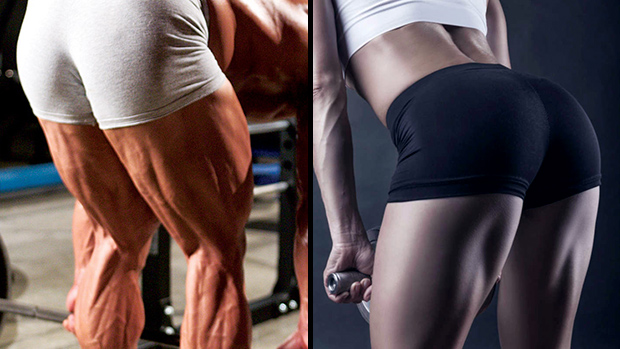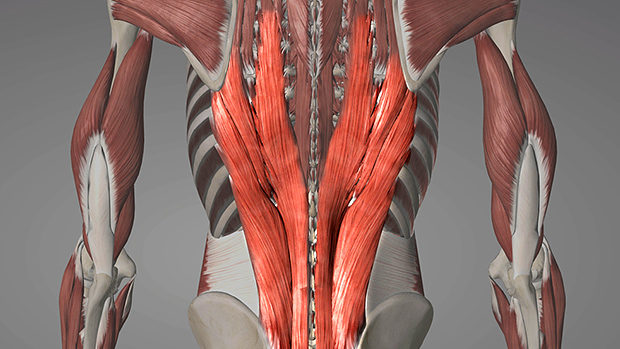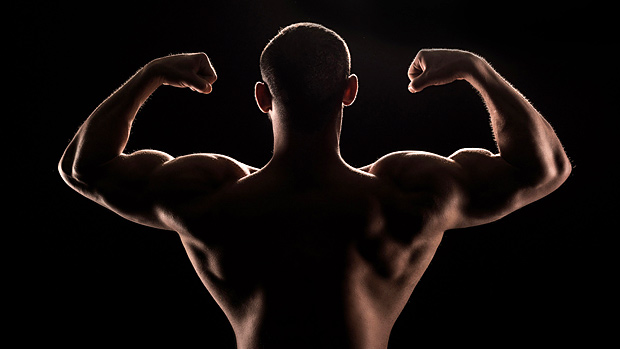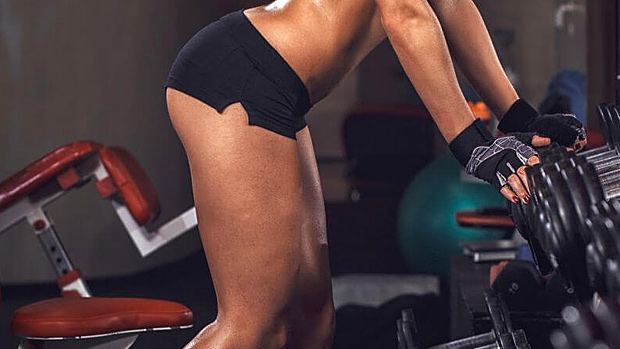Here's what you need to know...
- To get faster, more explosive, stronger, and even better looking, bring up your posterior chain. It's neglected by most lifters.
- Do lower body workouts twice a week and emphasize the glutes, hamstrings, and lower back muscles.
- Use a four-week "blitz" program containing walking lunges, power cleans, deadlift variations, leg curls, and more.
If you're like most lifters, your posterior chain is probably not where it should be. Your hams, glutes, and lower back are lagging in comparison to everything else.
And as a result, your squat, deadlift, and Olympic lifts aren't going up like they should. You may even have knee, hip, or nagging lower back issues. Your speed and explosiveness? Going nowhere!
In fact, almost nobody is as strong as they should be in their posterior chain.
Why? Because it's neglected in most training programs. Also, you can never be too strong in the posterior chain! As Louie Simmons says, "A strong athlete is strong in the back of his body."
- To bring up all your lifts, you need big and strong glutes, hams, and lower back muscles.
- To run faster, your glutes and hamstrings have to be extremely powerful to propel you forward. Those are your speed muscles. And a strong lower back allows you to maintain proper running mechanics.
- To dominate the stage, competitive bodybuilders need "hanging" hamstrings. They can set you apart from your competition – very few amateur bodybuilders have hamstrings that match their quads. And if you want striations in your glutes, well, you'll need to have glutes first!
- Do I even need to point out how important rounded hamstrings and glutes are to female lifters? And you know what? Women don't find guys with flat grandpa butts attractive either!
It's time you do something about your lagging posterior chain.

When you look at the standard lower body workout most lifters do in the gym, it shouldn't surprise you that their posterior chain is lagging. The average bodybuilding lower-body workout looks something like this:
- Squat variation
- Leg press or hack squat
- Lunge/split squat variation
- Leg extension
- Leg curl
While the back squat is a complete lower body movement, it still hits the quads much harder than the hamstrings, unless you're using an ultra-wide powerlifting squat or have super long limbs and a short torso.
And since few people seem to squat deep, the quads are even more emphasized.
The leg press and hack squat are very quad-dominant exercises, especially considering the range of motion use by most people. And if you go too deep on the leg press it can be hard on the lower back.
Lunges and split squats can involve the posterior chain a bit more, especially the glutes. But unless you're using long strides, the hams don't get that much work. Most people use shorter strides, so the quads still receive more stimulation.
Obviously leg extensions only hit the quads. And finally you hit the hams directly with leg curls, which still neglects the glutes.
So basically a typical lower body workout will have pretty much a 4:1 or 4:2 ratio of quads to posterior chain stimulation.
Deadlifts are often a "back day" exercise for bodybuilders. But the deadlift can indeed be a solid posterior chain exercise if the proper variation and correct form is used.
If you're using a regular deadlift, this means you're initiating the pull by pulling in a backward-upward arc: bringing the knees back, and the bar toward you at the start.
However, most bodybuilders – and other types of athletes except powerlifters who study the movement more – lift the barbell straight up which makes it a lower back-dominant exercise.
When deadlifting in a straight line, the hamstrings and glutes are not as involved as the quads which does nothing to counter the imbalanced development in favor of the quads.
The Romanian and sumo deadlifts are the variations you want to use to develop the glutes and hamstrings.
But even then, it's not enough to select these exercises. You must do them right. For example, in the Romanian deadlift many people bend at the trunk first instead of focusing on pushing the hips far back.
The distance the torso travels forward and down is actually irrelevant to the movement. Bending forward occurs in response to the hips moving back (to maintain balance). Don't focus on how far you can bend down. Focus on loading the hamstrings.
For the sumo deadlift, a lot of people simply do a deadlift with a wide stance. They pull the same way they pull their normal deadlift (high hips pulling in a straight line up) but with a wide stance.
This still keeps the movement lower-back dominant. You have to start the hips lower in a sumo deadlift and focus on bringing the hips forward explosively as you pass the knees.
So yes, doing deadlifts is one of the ways to correct a posterior chain weakness. But you have to pick the right variation(s) and do them in such a way that emphasizes the hamstrings and glutes.
When you want to bring up a lagging muscle group, stimulate it at least twice per week. Since most people have neglected the posterior chain for years, two stimulations will be adequate.
Do two lower body workouts a week. Make both heavily slanted toward the posterior chain. Keep a squat variation to continue developing the quads, but most of the work will be posterior-chain dominant.
When you have a lagging muscle group, bombard it with all you've got for 4 weeks, then move on.
To start, reduce the amount of direct quad work while you bring up the hamstrings. Don't worry, even though the exercises are posterior-chain dominant, the quads are involved enough to keep growing.
While both workouts will hit the glutes and hams, the first one will involve the hams a bit more while the second one will focus more on the glutes.
Workout A
| Exercise | Sets | Reps | |
|---|---|---|---|
| A | Power Clean from the Hang | 4 | 3 |
| B | Back Squat | 5 | 5 |
| C1 | Glute-Ham Raise | 3 | 6-8 |
| C2 | High Hips Sled/Prowler Pushing | 3 | 3 x 30 m. |
| D | Lying Leg Curl | 3 | * |
* Lying Leg Curl — 15 full reps + 15 top half reps + 15 bottom half reps
Workout B
| Exercise | Sets | Reps | |
|---|---|---|---|
| A | Power Clean | 4 | 3 |
| B1 | Romanian Deadlift (toes elevated) * | 3 | 6-8 |
| B2 | Wide Legs Sled/Prowler Pushing | 3 | 30 m. |
| B3 | Sumo Deadlift (same weight as RDL) | 3 | max |
| C1 | Kettlebell Dead Walk * | 3 | 15 m. |
| C2 | Kettlebell Dead-Start Walking Lunges | 3 | 15 m. |
| C3 | Kettlebell RDL (toes elevated) | 3 | 6-8 |
* See video.
1. Power Clean From The Hang
When you lower the barbell down to just above the knees, imagine that you're doing a Romanian deadlift; focus on stretching the hamstrings. Then focus on "standing up" as explosively as possible.
Use the explosive action of the legs and hips to give the barbell momentum upwards. The traps and arms do contribute to the pull, but only as the last moment, when the lower body already gave a lot of acceleration to the barbell.
Avoid pulling with the arms before the legs produced their power upwards.
2. Back Squat
Use a stance slightly wider than your hips and focus on keeping the torso upright (do not lean forward excessively). Go down as low as you can without losing your lower back arch.
If you feel that your pelvis is moving under – "butt wink" – you went too low. Go as deep as possible, but not at the expense of proper mechanics.
3. Glute-Ham Raise
Perfect these by learning from Ben Bruno. He gives a lot of great technical cues as well as progressions to use if you can't complete at least 6 solid reps.
You can also use a resistance band to help you complete the movement. Focus on keeping the abs tight to avoid over relying on the lower back.
4. High-Hips Sled Pushing
What we're after here is the greatest differential between hip and hands height. Keep those hips high at all times and fully extend at the knee joint on every push.
The goal is not to go fast, it's to feel the tension in the hamstrings during the whole push.
5. Lying Leg Curl
Keep the abs tight to avoid compensating with the lower back and keep the head in line with the spine.
6. Power Clean
The additional technical element for the power clean from the floor versus the lift from the hang is the passage from below the knees to above the knees. What needs to happen is that you initiate the pull from the floor with the hamstrings.
You do this by moving the knees back so that when the bar reaches the knees, the tibias are perpendicular to the floor. While you're doing this the bar is kept close to the body, so it's lifted in a slight backward arch.
When the bar reaches the upper third portion of the quadriceps, explode upwards with the legs, hips, and lower back. Focus on "standing up as explosively as possible."
Avoid pulling with the arms too early and don't accelerate until you pass the knees. The biggest mistake people make is starting too fast off the floor. Notice that the feet leave the floor, but it's not an upward jump; it's a lateral re-adjustment of the stance width.
7. Romanian Deadlift
This is for the toes-elevated barbell and kettlebell versions.
Whenever doing Romanian deadlifts or good mornings, try elevating the toes. It makes it much easier to tense and load the hamstrings, especially in those who are really flexible.
It's important not to think about bending forward, but only on pushing the hips back. The range of motion the barbell covers isn't important. What's important is maximally loading the hamstrings.
Keep the lower back arched; focus on pushing the hips back. The torso will bend forward in reaction to the hips moving back.
8. Wide Legs Sled or Prowler Pushing
The form is similar to the high hips pushing in Workout A, the difference is that now you use a wide stance to increase glute activation. Focus on squeezing the glutes on every stride.
9. Sumo Deadlift
Avoid raising the hips too fast when you lift off the floor. As soon as you pass the knees, snap those hips forward by squeezing the glutes.
10. Kettlebell Dead Walk
Keep the front leg extended, the lower back arched as much as possible, and push the hips back when you go down. You want to feel the hamstring of the front leg being loaded. When you stand up imagine dragging the floor back with your front heel.
11. Kettlebell Walking Lunges
Take long strides to involve the posterior chain more.
Normally on lunges I recommend staying upright to involve the quads more, but here I suggest a slight forward lean along with the wider strides to increase posterior chain activation.
Start every rep from a dead-start (kettlebell on the floor) and initiate the lift by squeezing the front glute.
What a Training Week Should Look Like
This blitz approach should last 4 weeks. During those weeks don't perform any other lower body movements or exercises in which the lower back is loaded (so no bent-over barbell rows for example).
There is a lot of stimulation for the whole lower body and lower back in these two workouts. If you want to progress optimally, let your body recover.
These workouts stimulate the posterior chain via all of their functions and several modes of contractions.
The variety of contraction types – concentric-only, explosive, eccentric focus, stretched position emphasis, contracted position emphasis, isolated, compound – will make your gains maximally transferable to any athletic capacity from sprinting and jumping to squatting and deadlifting heavy.
Because of the heavy focus on being stronger in the stretched position, it also greatly reduces the risk of suffering hamstring pulls in the future.
And of course, you will now look good from the back, not just the front!
Sample Training Split
- Monday: Leg Workout A
- Tuesday: Big pressing muscles (chest, deltoids)
- Wednesday: Off
- Thursday: Big pulling muscles (back and traps)
- Friday: Leg Workout B
- Saturday: Biceps and Triceps
- Sunday: Off





